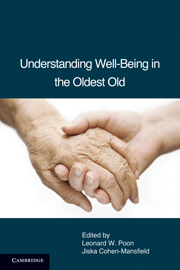Book contents
- Frontmatter
- Contents
- List of Tables
- List of Contributors
- Foreword by Carol D. Ryff
- PART I THEORY: NEW HORIZONS IN WELL-BEING RESEARCH
- PART II PARADISE LOST: BETWEEN TRAUMA AND HAPPINESS
- PART III PATHWAYS AND GATEKEEPERS: MODERATING, MEDIATING, AND PROXIMAL PROCESSES
- 9 Impact of Resources on Successful Adaptation among the Oldest Old
- 10 Nutrition and Well-Being
- 11 Cognitive Functioning and Vitality among the Oldest Old: Implications for Well-Being
- 12 Social Relationships and Well-Being in Very Late Life
- 13 Spirituality and Religiosity Connections to Mental and Physical Health among the Oldest Old
- 14 The Impact of Leisure Activity and Innovation on the Well-Being of the Very Old
- PART IV SIGNPOSTING PARADISE: MEASUREMENT OF WELL-BEING
- Index
- References
10 - Nutrition and Well-Being
Published online by Cambridge University Press: 05 August 2012
- Frontmatter
- Contents
- List of Tables
- List of Contributors
- Foreword by Carol D. Ryff
- PART I THEORY: NEW HORIZONS IN WELL-BEING RESEARCH
- PART II PARADISE LOST: BETWEEN TRAUMA AND HAPPINESS
- PART III PATHWAYS AND GATEKEEPERS: MODERATING, MEDIATING, AND PROXIMAL PROCESSES
- 9 Impact of Resources on Successful Adaptation among the Oldest Old
- 10 Nutrition and Well-Being
- 11 Cognitive Functioning and Vitality among the Oldest Old: Implications for Well-Being
- 12 Social Relationships and Well-Being in Very Late Life
- 13 Spirituality and Religiosity Connections to Mental and Physical Health among the Oldest Old
- 14 The Impact of Leisure Activity and Innovation on the Well-Being of the Very Old
- PART IV SIGNPOSTING PARADISE: MEASUREMENT OF WELL-BEING
- Index
- References
Summary
ABSTRACT
The relationship of nutrition-related factors with well-being in people 80 and older has received little attention. Therefore, this chapter explores the relationships of depression and depressive symptoms, as a measure of well-being, with appetite, body weight changes, underweight, and obesity as measures of nutritional status. The sample is from the Georgia Centenarian Study (aged 80 to 89 and 98+ years, see Chapter 9). In bivariate analyses, centenarians with depression consistently had the highest prevalence of underweight when compared to centenarians without depression and all octogenarians (23% to 33% vs. 0% to 16%). When controlled for other demographic factors, clinically relevant depressive symptomatology was associated with appetite loss, while a current diagnosis of depression was associated with recent changes in body weight. However, taking antidepressant medications was not associated with any of the nutrition-related measures. Demographic factors emerged as important predictors of nutritional status. Living in a skilled nursing facility compared to living in the community was associated with a lower risk of appetite loss and higher risk of weight gain; being a centenarian or being female was associated with underweight; and being Black (vs. White) was associated with obesity. Thus, risk factors for poor nutritional status in the oldest may be related to depression as well as to specific demographic factors including age, gender, race, and residence in a skilled nursing facility.
- Type
- Chapter
- Information
- Understanding Well-Being in the Oldest Old , pp. 171 - 185Publisher: Cambridge University PressPrint publication year: 2011



